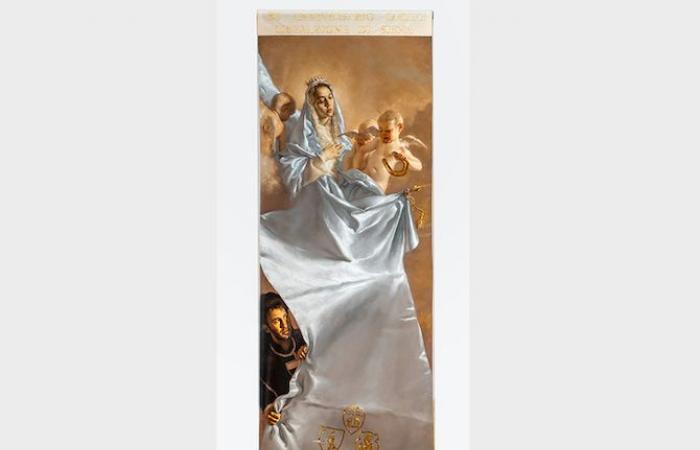Among the many famous artists who have painted a Siena Palio there are Renato Guttuso, Salvatore Fiume, Fernando Botero and Igor Mitoraj.
The Palio is a unique and fascinating challenge. In fact, as in the Middle Ages (remember Brunelleschi who every day, in the street, had to give an account to the Florentines of the dome he was building on Santa Maria del Fiore), competing in the Palio means submit to the judgment of an entire city, accustomed to living among great masterpiecesa community that for days observes, evaluates, discusses and then applauds the “rag” painted by the chosen painter or grumbles and disagrees.
THE SUBVERSIVE GASPARRO
This year the banner, for the Palio of July 2nd which is run in honor of the Madonna of Provenzano (the Marian sanctuary of Siena), was commissioned to John Gasparro. Painter, already highly appreciated at a young age, who created an enchanting workearning the enthusiastic consensus of the Tuscan city.
The essential requirement that a banner must have is the image of the Virgin (sovereign of Siena for centuries) because, in the days of the Palio, Siena he suspends time and returns to being his Queen’s alonethat is, it rediscovers its great medieval civilization, forgetting the historical wound – the Spanish and Florentine conquest – which in the 16th century put an end to its independence.
In modern times the figure of the Madonna is depicted on the banners sometimes a little marginal. Instead In Gasparro’s painting the Virgin – young, beautiful and very realistic – is the dominant figure.
This painter – who has made a name for himself in recent years for his very high quality of his works and for his Caravaggesque style – he is clearly and luminously Catholic. The exhibition of some of his works, right in the public palace of Siena until June 27th, made this clear to everyone.
In the time of de-Christianization and the pictorial avant-gardes, which for a century have rejected the representation of the human figure, Gasparro is a subversive for two reasons: the sacredness of the subjects and the figurative choice, characterized by a vigorous physicality which – to the Caravaggio style – he adds hyperrealism in the representation of bodiesfrom the flesh that – in their falling imperfection (the same as our bodies) – they bear the mark of the painful human condition.
Here the flesh cries out, seeks redemption, liberation, then resurrection when our bodies themselves will be resurrected, glorified and divinized, eternally young and in the beauty of Christ..
THE RELIGION OF THE BODY
Gasparro’s art reminds us of the very close connection between Christianity and the body and reminds us that Christian art has always been the exaltation of the human figure. By Giotto and Nicola Pisano (for painting and sculpture) up to Michelangelo which made the Sistine Chapel – as John Paul II said – “the sanctuary of the theology of the human body”.
“If there is an era” writes Tomaso Montanari “in which the body is truly everything in the history of art, well that era is the Renaissance when, we could say, art truly returns to incarnate itself. ‘And the Word became flesh and came to dwell among us’. John had announced it, at the beginning of his Gospel”.
God becoming man, he adds, “is the celebration of our flesh, that is, of our reality, of our weakness, of our fragility. We celebrate the distant God who comes to pitch his tent among men, who takes on their flesh and therefore shares their destiny. The God who, by humanizing himself, divinizes man.”.
Antonio Socci
From “Libero”, June 29, 2024






